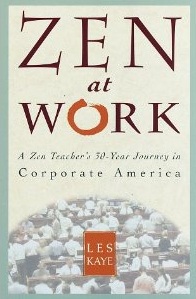Zen At Work: A Zen Teacher’s 30-Year Journey in Corporate America
Les Kaye
Review By Dan Geddes
Zen At Work is a striking title for a book, precisely because it sounds paradoxical. “Zen” conjures up images of bald, white-robed men sitting in the lotus position pondering eternal verities, while “work” produces more mundane images: perhaps white-collar professionals performing routine and/or purely mercenary tasks. The purpose of Zen At Work is to show us why the notion of practicing Zen at work is not only not paradoxical but wholly harmonious with Zen philosophy and even a crucial aspect of Zen practice.
Zen At Work is effective largely because of Kaye’s credentials: He is a retired IBM manager of 30 years’ standing, as well as a long practicing Zen monk. Kaye’s inspirational passages about proper attitudes are interspersed with anecdotes from his years at IBM and at various Zen monasteries in California. He illustrates how relationships at work are arenas for emotional struggles, and it benefits us to see how important working relationships really are to us.
Kaye studied under Suzuki-Roshi, an important advocate of the Soto Zen tradition in Califorinia in the 1960s. Suzuki’s approach to life, recorded in Zen Mind, Beginner’s Mind, stressed the importance of practicing Zen in ordinary situations: sitting, driving, working at a desk. The purpose of Zen, for Suzuki-roshi, is not the earth-shattering metaphysical enlightenment espoused by other Zen schools, but rather that practicing zazen (Zen sitting and posture) itself expresses an attitude toward the world. It expresses the focus of our lives in the present moment, a focus we should bring to bear on all activities. Zen is a discipline that brings immediate calming benefits, and should be seen as an end-in-itself rather than as a means of achieving other goals.
One of the chief benefits of practicing zazen is that it fosters an open mind, what Kaye calls an “empty mind,” similar to the “beginner’s mind” from the title of Suzuki-Roshi’s book.. An empty mind is a fitting response to the impermanence of all worldly phenomena. Empty minds are more nimble; and delusion is caused by clinging to fleeting images.
Perhaps my favorite quotation from this book is: “We can always have the spontaneity of childhood, the freedom and curiosity of youth, the creativity and responsibility of midlife, and the wisdom of later years” (132). I also enjoyed the admonition to not label activities as “exciting” or “boring,” or “work” or “leisure.”
Zen at Work made zen practice seem compatible with pursuing a professional career in America.

